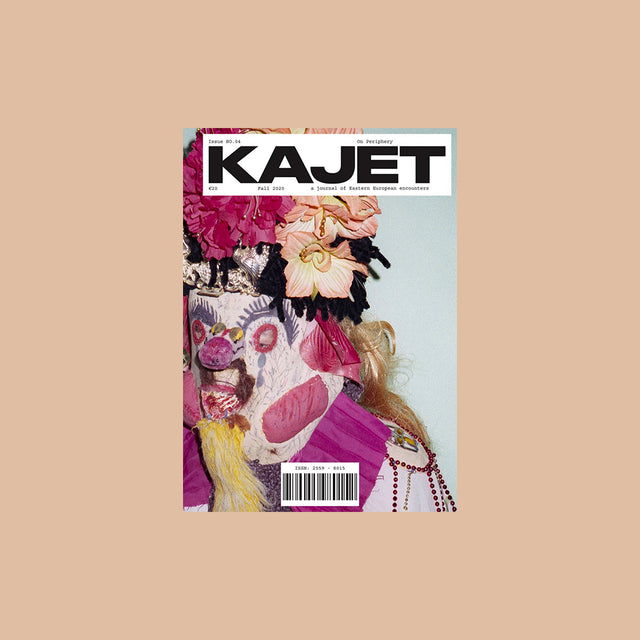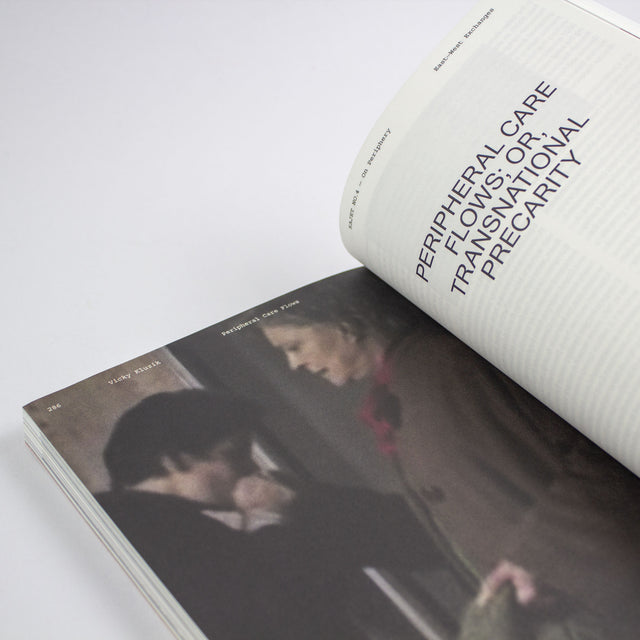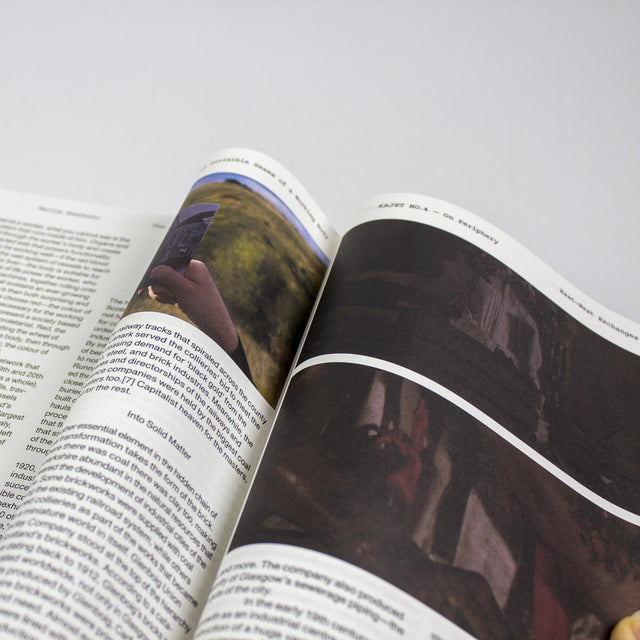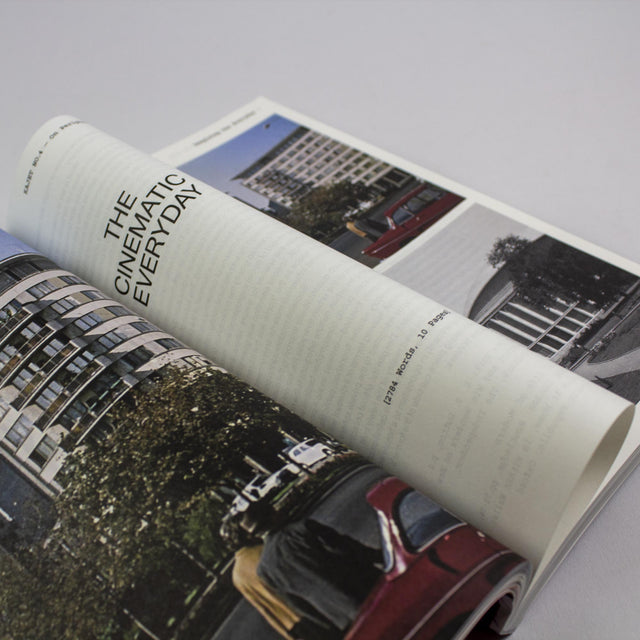






KAJET Journal No. 04 – On Periphery
By producing an archaeology of the periphery, the fourth issue of Kajet explores the possibility of a revised vision for the future of Europe, not in a totalising manner, but in a critical, reflexive way. Kajet alerts the centre of the possibility that there is not one world, not one history, not one future without alternatives, but rather many disparate worlds that are being lived at different speeds, according to different rhythms, producing contradictory histories and futures. Paradoxes are therefore necessary: to remain local but open, homogenous but plural, rooted yet adrift, anchored yet aware of what happens beyond one’s proximity. Our periphery is European and elsewhere altogether.
Authors: Attila Antal, Patricia Becuș, Marek M. Berezowski, Dragoș Boțcău, Julien Britnic, Carnation Studio (Horațiu Șovăială & Raya al Souliman), Alexandra Chiriac, Roberta Curcă, Dezarticulat, Andreea Daniela Dițu, Alex Fisher, Stefan Fraunberger, Flóra Gadó, Anton Hryhorenko, Daniel Hüttler, Ștefan Ionescu-Ambrosie, Jan Jurczak, Kadna, Vicky Kluzik, Ramin Mazur, Zsolt Miklósvölgy, Marija Nemčenko, Karol Radziszewski, Christina Novakov-Ritchey, Johanna Rannula, Alin Răuțoiu, Patrycja Rozwora, Elizabeth Short, Horațiu Șovăială, Ioana Țîștea, Lucian Varvaroi, Laura Naum, Petrică Mogoș
About Kajet
Ever since the fall of the Berliner Mauer, a fair amount of Eastern European nations has been formally greeted into the more prosperous & privileged family known as the ‘European Union.’ Despite that their Western counterparts have (slowly, yet steadily) come to acquire—along with a mystifying cloak of noxious preconceptions—some generalised ideas about Eastern Europe, proportionately few specks of knowledge have been disseminated vis-à-vis its art, culture, society, & politics. Moving beyond mere utterances of discontent or embittered reflections, our journal aims to tackle (some of) the inconsistencies that govern over this part of Europe.
Undeterred by its constant position as l’autre in the world order paradigm, Eastern Europe is more than just itinerant gloom, more than a sheer pile of debris hanging around & awaiting reconstruction. Especially in the current turbulent socio-political climate that has led to an upsurge of xenophobia, bigotry, & ultranationalism, the mere act of getting together—of maintaining a state of togetherness regardless of ethnic, racial, cultural, social, class differences—needs to be more critically investigated. The moment of this publication, therefore, points toward historical contingencies, as the atomisation of individuals into egoistic & parsimonious globules of greed, into disengaged, demoralised, socially powerless beads, & into aphasic post-socialist subjects without a clear sense of direction, has led to a palpable undermining of Eastern European communities.
Getting together represents, after all, the ultimate habit of humanity. Yet, in the midst of increasingly alienating & divisive times, seeking (& finding) one’s sense of belonging has come to seem remotely beyond the bounds of possibility. Focusing on the collective rather than the individual, we believe that vulnerability takes root in isolation, whereas true power lies in togetherness. We believe that alone we are weak and that only together we can become strong. Concentrating the scope of interest onto the past, present, & future of communities inside Eastern Europe, you can find what lies at the heart of our first issue: a rejuvenation of the contemporary imaginations of what the notion of community used to mean, currently means, & will continue to mean.
Born in Titan, a (former?) working class neighbourhood of Bucharest, KAJET Journal emanated out of an urgent need to provide a platform for Eastern European narratives. Aiming to become a timeless archival document, KAJET gets its name from the Easternised version of the French cahier, meaning notebook. It embodies the ethos of KAJET: a textual & visual collection of thoughts, an assemblage of neglected narratives, a self-expanding string of reflections & perspectives, a perpetual work in progress of a history that keeps re-writing itself; essentially, a journal of Eastern European encounters. With KAJET bearing the piercing & onerous legacy of samizdat endeavours of this region’s past, the project hopes to become an alternative medium where artists & academics can actively co-exist & thrive (not in the least in imagination & in writing, but hopefully more than that).
Through a textual & visual composite, we seek to move beyond a purely anecdotal understanding of Eastern Europe, as we aim to reverse mentalities, challenge stereotypes, & shift perspectives. Dealing with (re)articulations of the intellectual, artistic, & cultural, KAJET also challenges the current distribution of printed material within Europe—fundamentally, we aim to counterbalance & expand an overly Western-oriented field toward the Eastern end of the spectrum.
In its perpetual quest for self-determination, we believe that Eastern Europe shall neither ignore nor reject its very own characteristics: a simmering cauldron, a melting pot, a fusing constellation with its own power struggles, a world led through inner social dynamics vitiated by congenital corruption, as well as stubborn memories that refuse to fade away. Instead, as Eastern Europeans ourselves, we attempt to dismantle the aura of mythical irrationality that obscures the popular belief, together with the region’s counterfeit sense of inferiority against the powerful, the prosperous, & the advanced. Should that happen, this publication will have achieved its purpose.
GUDBERG NERGER
MON – SAT, 12:00 - 18:00
Poolstrasse 8 | 20355 Hamburg - Germany
Phone: +49(0)40 - 81 95 15 0
QUICK LINKS
About | Agency | Shop | Gallery | Feed | Contact | Virtual Tour | Jobs | Imprint | Privacy Policy | Shipping & Payment | Login
FOLLOW US
Instagram | Facebook | Linkedin | Pinterest | Newsletter

Copyright © 2025 GUDBERG NERGER
